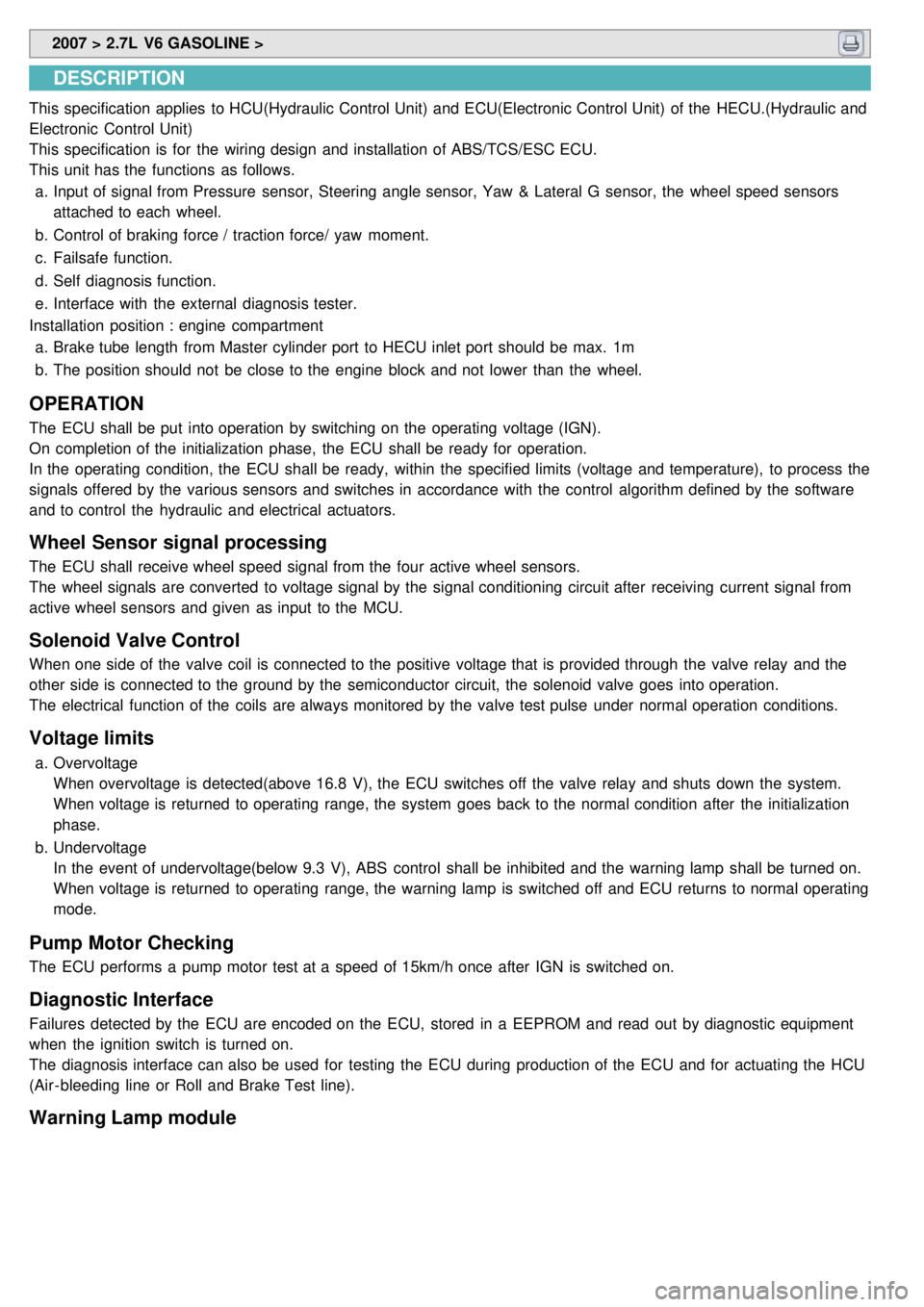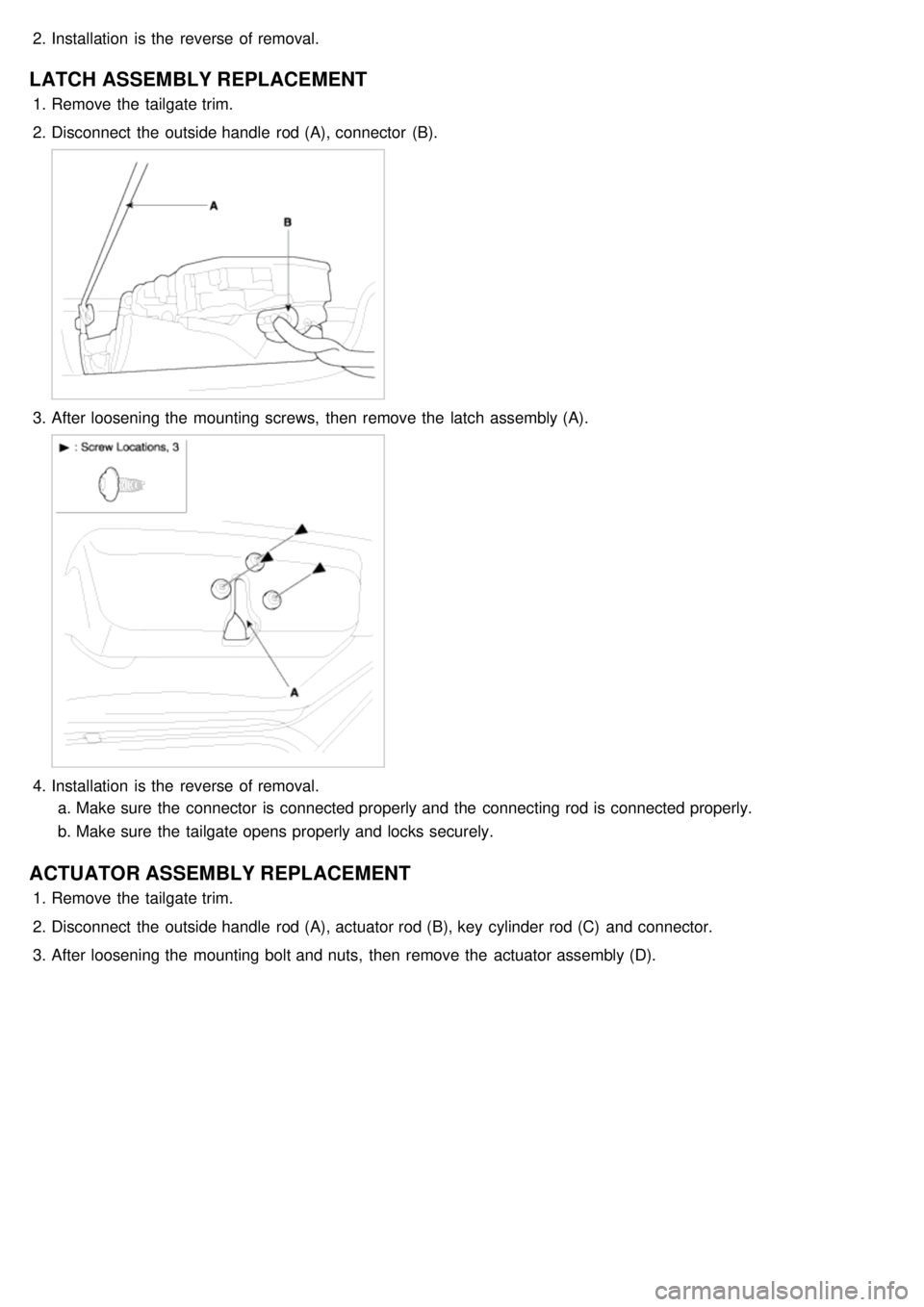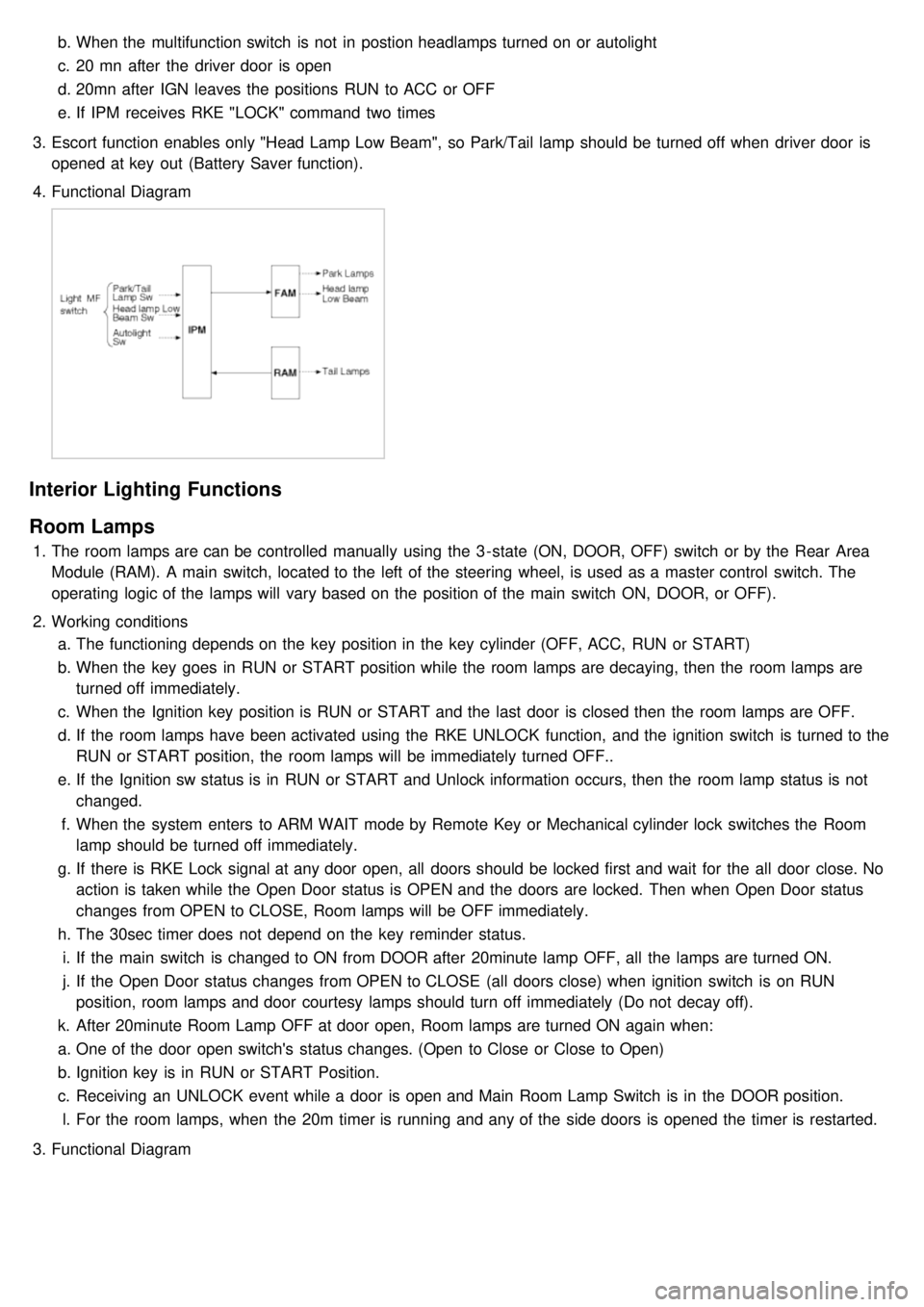2007 KIA CARNIVAL CYLINDER
[x] Cancel search: CYLINDERPage 900 of 1575

If you are reusing the pads, always reinstall the brake pads in their original positions to prevent a momentary
loss of braking efficiency.
3.Insert the piston in the cylinder using the special tool (09581- 11000).
4.Push in the piston (A) so that the caliper will fit over the pads. Make sure that the piston boot is in position to
prevent damaging it when pivoting the caliper down.
5. Being careful not to damage the pin boot, install the guide rod bolt (B) with the specified torque.
6.If caliper assembly was removed, install the brake hose to the caliper.
7. Refill the master cylinder reservoir to the MAX line.
8. Bleed the brake system.(Refer to 'Bleeding of ABS system')
9. Depress the brake pedal several times to make sure the brakes work, then test- drive.
Engagement of the brake may require a greater pedal stroke immediately after the brake pads have been
replaced as a set. Several applications of the brake will restore the normal pedal stroke.
Page 906 of 1575

4.Grease the piston boot to prevent from twisting.
5. Install the guide rod.
6. Install the cylinder assembly (A) to the disc plate.
Be careful not to damage the piston boot.
7.Install the guide rod bolt (B).
Tightening torque Nm(kgf.m,lb - ft) :
22 ~ 32 (2.2 ~ 3.2, 15.9 ~ 23.1)
INSPECTION
REAR BRAKE DISC THICKNESS CHECK
1. Remove all rust and contamination from the disc surface, and then measure the disc thickness at 8 points, al least,
of the same distance (5 mm(0.12 in)) from the brake disc outer circle.
Rear brake disc thickness
Standard value : 12.0 mm (0.47 in)
Limit : 10.4 mm (0.41 in)
2. Thickness variation should not exceed 0.01 mm(0.0004 in) (circumference) and 0.01 mm(0.0004 in) (radius) at any
directions.
3. If wear exceeds the limit, replace the discs and pad assembly for left and right of the vehicle.
Page 928 of 1575

2007 > 2.7L V6 GASOLINE >
DESCRIPTION
This specification applies to HCU(Hydraulic Control Unit) and ECU(Electronic Control Unit) of the HECU.(Hydraulic and
Electronic Control Unit)
This specification is for the wiring design and installation of ABS/TCS/ESC ECU.
This unit has the functions as follows.
a. Input of signal from Pressure sensor, Steering angle sensor, Yaw & Lateral G sensor, the wheel speed sensors
attached to each wheel.
b. Control of braking force / traction force/ yaw moment.
c. Failsafe function.
d. Self diagnosis function.
e. Interface with the external diagnosis tester.
Installation position : engine compartment a. Brake tube length from Master cylinder port to HECU inlet port should be max. 1m
b. The position should not be close to the engine block and not lower than the wheel.
OPERATION
The ECU shall be put into operation by switching on the operating voltage (IGN).
On completion of the initialization phase, the ECU shall be ready for operation.
In the operating condition, the ECU shall be ready, within the specified limits (voltage and temperature), to process the
signals offered by the various sensors and switches in accordance with the control algorithm defined by the software
and to control the hydraulic and electrical actuators.
Wheel Sensor signal processing
The ECU shall receive wheel speed signal from the four active wheel sensors.
The wheel signals are converted to voltage signal by the signal conditioning circuit after receiving current signal from
active wheel sensors and given as input to the MCU.
Solenoid Valve Control
When one side of the valve coil is connected to the positive voltage that is provided through the valve relay and the
other side is connected to the ground by the semiconductor circuit, the solenoid valve goes into operation.
The electrical function of the coils are always monitored by the valve test pulse under normal operation conditions.
Voltage limits
a.Overvoltage
When overvoltage is detected(above 16.8 V), the ECU switches off the valve relay and shuts down the system.
When voltage is returned to operating range, the system goes back to the normal condition after the initialization
phase.
b. Undervoltage
In the event of undervoltage(below 9.3 V), ABS control shall be inhibited and the warning lamp shall be turned on.
When voltage is returned to operating range, the warning lamp is switched off and ECU returns to normal operating
mode.
Pump Motor Checking
The ECU performs a pump motor test at a speed of 15km/h once after IGN is switched on.
Diagnostic Interface
Failures detected by the ECU are encoded on the ECU, stored in a EEPROM and read out by diagnostic equipment
when the ignition switch is turned on.
The diagnosis interface can also be used for testing the ECU during production of the ECU and for actuating the HCU
(Air - bleeding line or Roll and Brake Test line).
Warning Lamp module
Page 950 of 1575

2007 > 2.7L V6 GASOLINE >
REMOVAL
1.Remove the air cleaner. (Refer to 'Master cylinder Removal')
2. Disconnect the brake tube from the HECU by unlocking the nuts counterclockwise with a spanner.
3.Disconnect the connector(A) from the HECU.
4.Remove the two HECU brake mounting bolts(B) , and then disassemble the HECU with the bracket.
a.Never attempt to disassemble the HECU.
b. The HECU must be protected during storage and transport, and must not be subjected to excessive shock.
5. Remove the two HECU mounting nuts (C) and washer, and then remove the bracket.
INSTALLATION
1.Installation is the reverse of removal.
2. Tighten the HECU mounting bolts and brake tube nuts to the specified torque.
Page 994 of 1575

2007 > 2.7L V6 GASOLINE >
SPECIFICATIONS
HOOD Type Rear hinged, gas lifter type
REAR DOOR Construction
Regulator system
Locking system Front hinged, full door construction
X- ARM type
Pin- fork system
FRONT DOOR Construction
Regulator system
Locking system Sliding door construction
Wire drum type
Pin- fork system
TAILGATE Type Inner hinged, gas lifter type
GLASS
THICKNESS Windshield glass
Front door glass
Rear door glass
Rear window glass 5mm
4mm
4mm
3.5mm
SEAT BELTS Front
Rear 3 point type with Emergency Locking Retractor
(E.L.R)
3 point type with Emergency Locking Retractor
(E.L.R)
TIGHTENING TORQUE
Items
N.mKgf.m Lbf.ft
Front and rear doors Door hinge to body
Door hinge to door
Striker
Glass mounting bolt
Outside handle mounting bolt
Rear channel mounting nut 33.3~41.2
21.6~26.5
6.9~10.8
7.8~11.8
6.9~10.8
7.8~11.8 3.4~4.2
2.2~2.7
0.7~1.1
0.8~1.2
0.7~1.1
0.8~1.224.6~30.4
15.9~19.5
5.1~8.0
5.8~8.7
5.1~8.0
5.8~8.7
Tailgate Tailgate hinge to body
Tailgate hinge to tailgate
Tailgate lift mounting bolt
Key cylinder mounting nut 6.9~8.8
6.9~8.8
6.9~8.8
6.9~10.8 0.7~0.9
0.7~0.9
0.7~0.9
0.7~1.15.1~6.5
5.1~6.5
5.1~6.5
5.1~8.0
Hood Hood hinge to body
Hood hinge to hood
Hood latch to body 21.6~26.5
21.6~26.5
6.9~10.8 2.2~2.7
2.2~2.7
0.7~1.115.9~19.5
15.9~19.5
5.1~8.0
Seat Front seat mounting bolts
Rear seat mounting bolts 43.1~64.7
43.1~64.74.4~6.6
4.4~6.631.8~47.7
31.8~47.7
Seat belt Front seat belt height adjuster
Front seat belt buckle
mounting bolt
Front seat belt anchor
mounting bolt
Front seat belt lower anchor
Front seat belt upper anchor
Rear seat belt anchor
attaching bolt
Rear seat belt retractor
mounting bolt 39.2~53.9
39.2~53.9
39.2~53.9
39.2~53.9
39.2~53.9
39.2~53.9
39.2~53.9
4.0~5.5
4.0~5.5
4.0~5.5
4.0~5.5
4.0~5.5
4.0~5.5
4.0~5.528.9~39.8
28.9~39.8
28.9~39.8
28.9~39.8
28.9~39.8
28.9~39.8
28.9~39.8
Page 1011 of 1575

2.Installation is the reverse of removal.
LATCH ASSEMBLY REPLACEMENT
1.Remove the tailgate trim.
2. Disconnect the outside handle rod (A), connector (B).
3.After loosening the mounting screws, then remove the latch assembly (A).
4.Installation is the reverse of removal.
a. Make sure the connector is connected properly and the connecting rod is connected properly.
b. Make sure the tailgate opens properly and locks securely.
ACTUATOR ASSEMBLY REPLACEMENT
1.Remove the tailgate trim.
2. Disconnect the outside handle rod (A), actuator rod (B), key cylinder rod (C) and connector.
3. After loosening the mounting bolt and nuts, then remove the actuator assembly (D).
Page 1217 of 1575

activation.
3. Functional diagram
Battery Saver Function
1.Necessary conditions to activate the Battery Saver function:
a. Do not turn off the Park/Tail Lamp when intentionally turned on.
b. If Key reminder switch is ON and Park/Tail Lamp switch is ON, Intentional "ON" should be reset
c. If the driver's door is open and if the key is not in the key hole whereas the Head lamp switch is still in position
'Park and tail lamp' or 'Head lamp Low Beam', the park and tail lamps (and the Front fog lamps if turned on)
are immediately turned off.
2. Necessary conditions to cancel the Battery Saver function:
a. As soon as the Key is input into the IGN Key Cylinder or the Head lamp switch is put to position OFF.
3.Functional diagram
Escort Function
1.If the head lamps low beam are turned on by head lamps low beam switch or by auto light switch when the Ignition
switch is turned from the ON to ACC or OFF positions.
2. The head lamps low beam are turned off:
a. 30s after the driver door is closed
Page 1218 of 1575

b.When the multifunction switch is not in postion headlamps turned on or autolight
c. 20 mn after the driver door is open
d. 20mn after IGN leaves the positions RUN to ACC or OFF
e. If IPM receives RKE "LOCK" command two times
3. Escort function enables only "Head Lamp Low Beam", so Park/Tail lamp should be turned off when driver door is
opened at key out (Battery Saver function).
4. Functional Diagram
Interior Lighting Functions
Room Lamps
1.The room lamps are can be controlled manually using the 3 - state (ON, DOOR, OFF) switch or by the Rear Area
Module (RAM). A main switch, located to the left of the steering wheel, is used as a master control switch. The
operating logic of the lamps will vary based on the position of the main switch ON, DOOR, or OFF).
2. Working conditions
a. The functioning depends on the key position in the key cylinder (OFF, ACC, RUN or START)
b. When the key goes in RUN or START position while the room lamps are decaying, then the room lamps are
turned off immediately.
c. When the Ignition key position is RUN or START and the last door is closed then the room lamps are OFF.
d. If the room lamps have been activated using the RKE UNLOCK function, and the ignition switch is turned to the
RUN or START position, the room lamps will be immediately turned OFF..
e. If the Ignition sw status is in RUN or START and Unlock information occurs, then the room lamp status is not
changed.
f. When the system enters to ARM WAIT mode by Remote Key or Mechanical cylinder lock switches the Room
lamp should be turned off immediately.
g. If there is RKE Lock signal at any door open, all doors should be locked first and wait for the all door close. No
action is taken while the Open Door status is OPEN and the doors are locked. Then when Open Door status
changes from OPEN to CLOSE, Room lamps will be OFF immediately.
h. The 30sec timer does not depend on the key reminder status.
i. If the main switch is changed to ON from DOOR after 20minute lamp OFF, all the lamps are turned ON.
j. If the Open Door status changes from OPEN to CLOSE (all doors close) when ignition switch is on RUN
position, room lamps and door courtesy lamps should turn off immediately (Do not decay off).
k. After 20minute Room Lamp OFF at door open, Room lamps are turned ON again when:
a. One of the door open switch's status changes. (Open to Close or Close to Open)
b. Ignition key is in RUN or START Position.
c. Receiving an UNLOCK event while a door is open and Main Room Lamp Switch is in the DOOR position.
l. For the room lamps, when the 20m timer is running and any of the side doors is opened the timer is restarted.
3. Functional Diagram